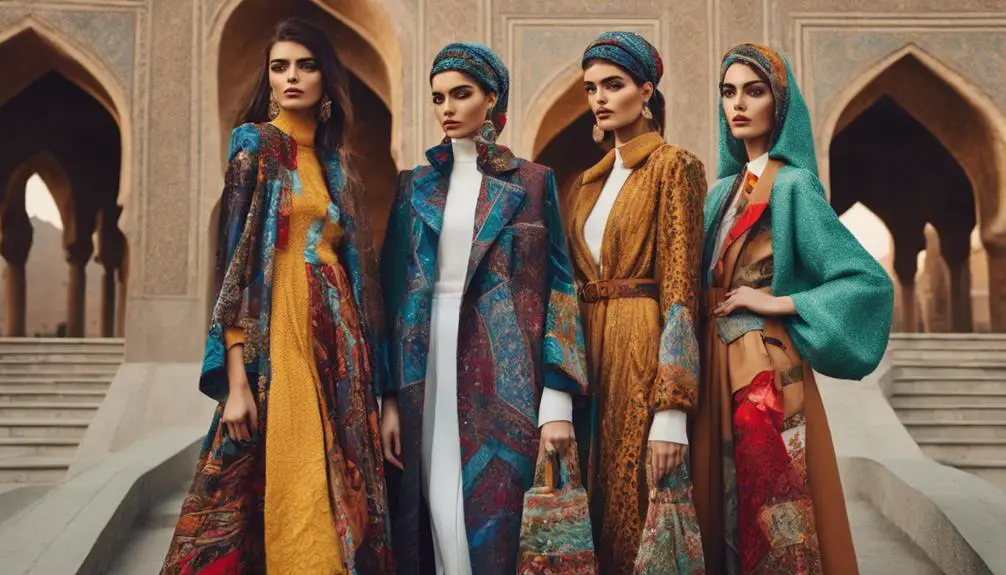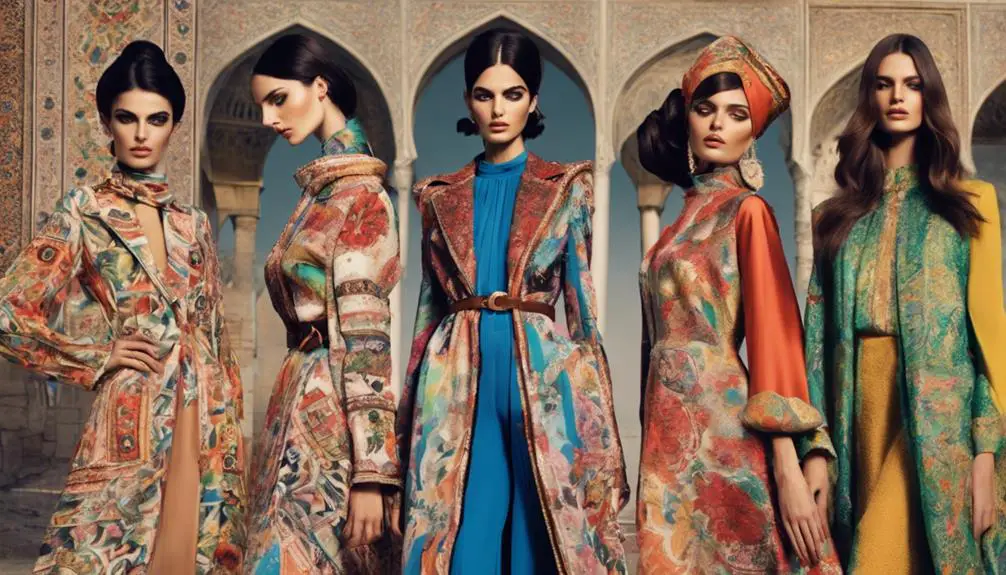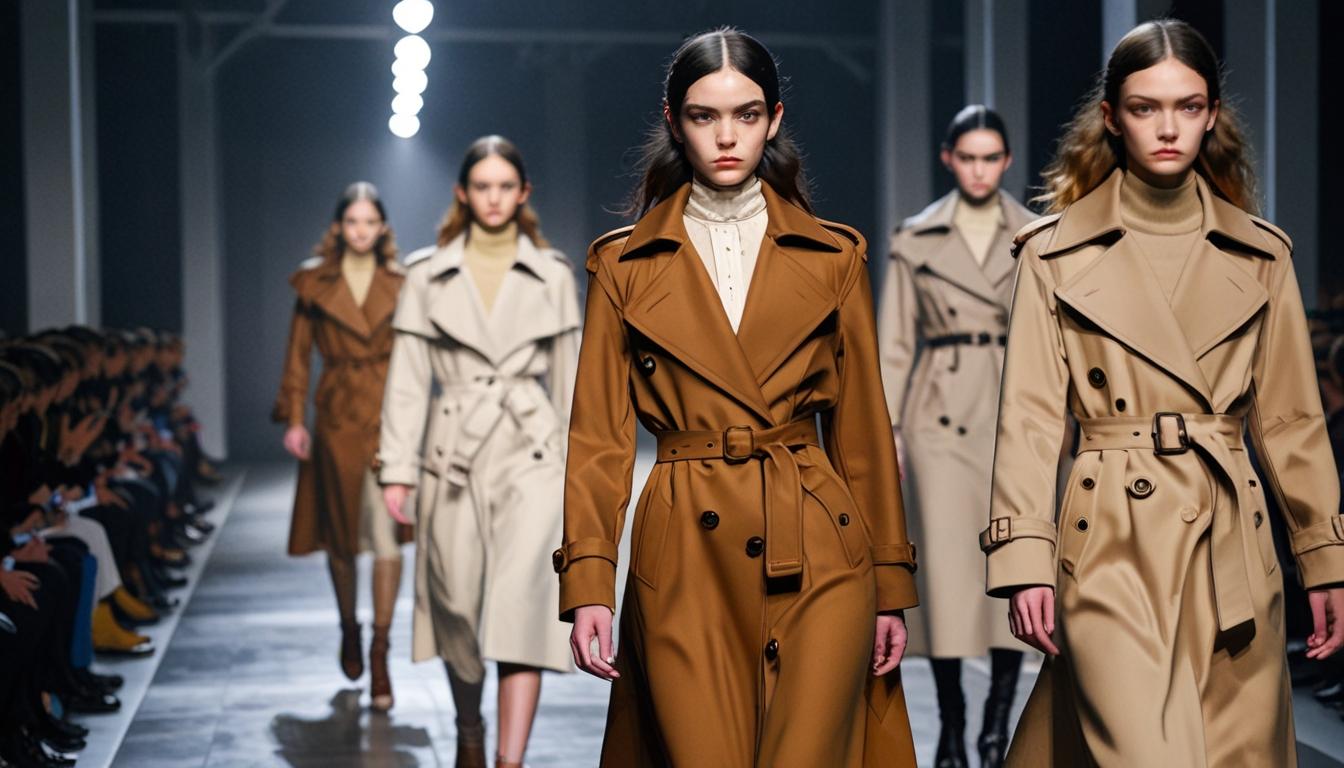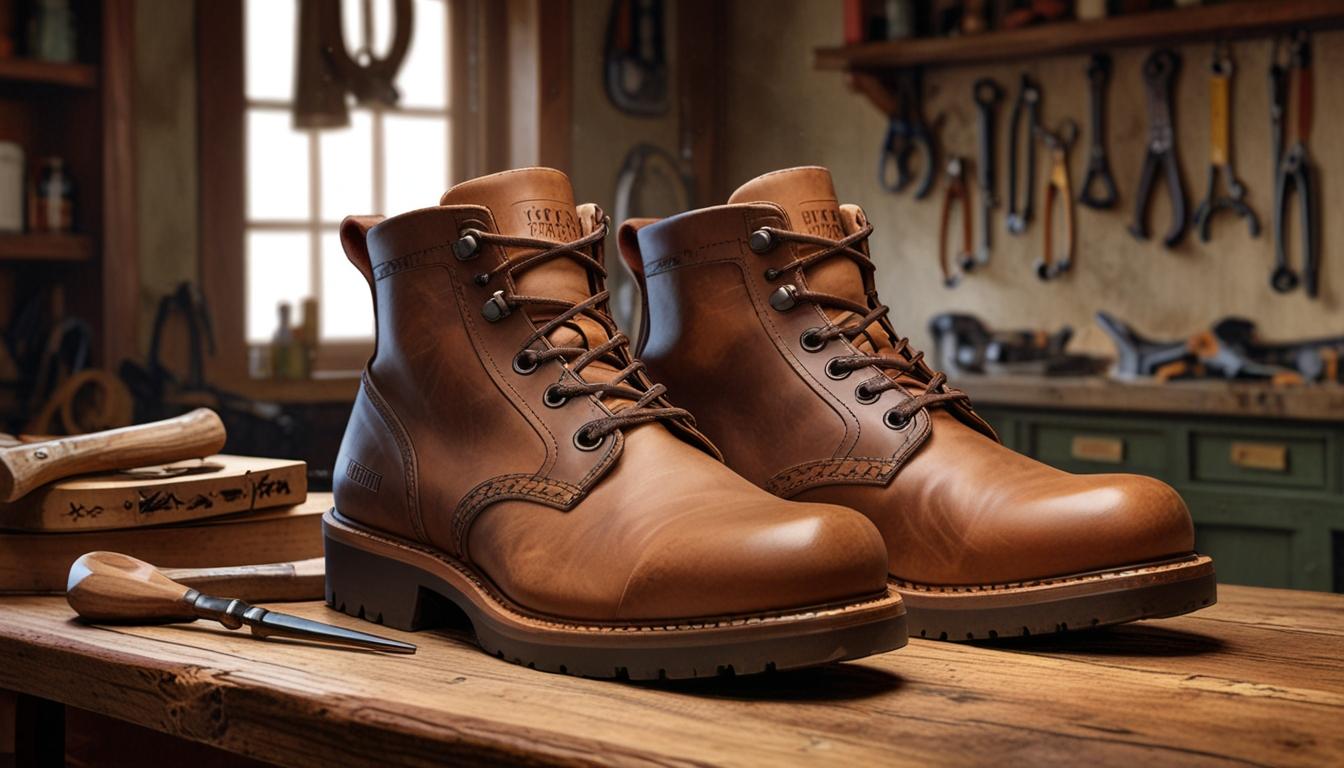When you think of famous Iranian fashion models, names like Sahar Biniaz and Mahlagha Jaberi immediately come to mind. They've made waves in the industry, blending their rich culture with contemporary fashion. You can't overlook Bahar Soomekh and Nazanin Afshin-Jam, both known for their stunning looks and impactful careers. These models not only challenge traditional beauty standards but also advocate for women's rights, reshaping global perceptions of Iranian elegance. They symbolize a dynamic blend of history and modernity in fashion. Intrigued by how these trailblazers are influencing the style landscape today? There's even more to discover!
Overview of Iranian Fashion Models

Iranian fashion models are making a significant mark in the industry, and their unique blend of traditional and modern styles sets them apart. These talented Iranian women are redefining beauty standards, showcasing a fascinating mix of cultural heritage and contemporary flair. With their striking features and ability to navigate the fashion world, they've become influential figures both locally and internationally.
Models like Bahar Soomekh and Yasmin Le Bon have gained recognition for their work in high-profile campaigns and runway shows, proving that Iranian women can excel on global platforms. However, the journey isn't always smooth. Many Iranian models face challenges, including strict dress codes and societal expectations, which can limit their opportunities within Iran. Despite these hurdles, they continue to build resilient fashion identities that resonate with audiences worldwide.
The rise of social media has played an essential role in amplifying their voices and showcasing their artistry. Through Instagram and other platforms, Iranian models can present their work and advocate for women's rights, challenging stereotypes and promoting a modern image of Iranian women. Their commitment to cultural representation not only enriches the fashion landscape but also fosters a greater appreciation for diversity in beauty.
Prominent Figures in Modeling
The allure of Iranian fashion models fascinates audiences worldwide, as they break barriers and redefine beauty norms. Among the prominent figures in modeling, Sahar Biniaz stands out, having gained international recognition as Miss Universe Canada 2012. Her participation in various beauty pageants has considerably enhanced the visibility of Iranian beauty on global platforms.
Nazanin Afshin-Jam, a former Miss World contestant, showcases the multifaceted nature of these icons. She's not only a model but also a passionate advocate for human rights in Iran, successfully shifting into music and acting. This remarkable versatility expands her influence beyond the domain of modeling, inspiring many along the way.
Another notable figure is Mandana Karimi, who gained fame as both a model and actress. With her work on international projects and a substantial social media following, she effectively showcases Iranian beauty and culture, enchanting audiences with her talent and charisma.
Mahlagha Jaberi is celebrated for her striking looks and has become a sought-after model in various fashion campaigns and magazines. Often compared to Persian miniatures, her beauty has made a lasting impression on the fashion industry.
Lastly, Shermine Shahrivar, who won Miss Europe 2005, has carved out a successful modeling career in Germany. Her achievements contribute to the representation of Iranian women in the competitive European fashion scene. Together, these prominent figures elevate Iranian fashion modeling, inspiring future generations to embrace their own unique beauty.
Cultural Impact and Representation

Influencing global fashion trends, Iranian female models seamlessly blend traditional and modern aesthetics, highlighting their rich cultural heritage. These talented Iranian models not only showcase their unique styles on international runways but also challenge stereotypes, helping foster a greater understanding of Iranian culture and beauty. By incorporating elements of their heritage into high-fashion contexts, they create a conversation around the diverse narratives that shape our world.
Many Iranian models use their platforms effectively, advocating for women's rights and contributing to important global discussions surrounding gender equality and cultural representation. This advocacy is essential, as it encourages others to recognize the strength and resilience of Iranian women, promoting a more nuanced perspective.
Social media has played a pivotal role in amplifying the reach of Iranian models, allowing them to challenge societal norms and redefine perceptions of beauty. By sharing their journeys and experiences, they inspire others to embrace their identities and celebrate diversity. This newfound visibility contributes to the increasing acceptance of varied beauty standards within the fashion industry, paving the way for new generations of aspiring models from Iran.
As Iranian models gain recognition and acclaim, they reshape global perceptions of Iranian women, proving that beauty transcends borders and cultural barriers. Their impact is profound, as they not only represent their country but also inspire a movement toward inclusivity and appreciation for multiculturalism in fashion. In this way, they become powerful symbols of progress and change.
Challenges in the Fashion Industry
Steering through the fashion industry in Iran is fraught with challenges that greatly impact models' careers. Since the Islamic revolution, the landscape has shifted dramatically, introducing strict dress codes and societal expectations that often limit what models can wear and how they can express themselves. Maneuvering these challenges in the fashion industry means that Iranian models frequently face regulatory restrictions, including censorship and bans on certain types of attire, which complicate their ability to showcase their talents and styles.
Furthermore, many female models encounter backlash and social stigma from conservative segments of society, making their pursuit of a modeling career even more intimidating. This societal pressure can be disheartening, as it not only affects their confidence but also their opportunities for advancement in a competitive field. On top of that, economic instability in Iran poses significant hurdles, impacting the sustainability of the fashion industry. Models struggle to secure consistent work, while designers find it difficult to flourish amidst these hardships.
Additionally, ongoing debates surrounding compulsory hijab laws create a complex landscape for models, hampering their freedom to fully express their personal style and identity in their professional work. Despite these obstacles, the resilience and creativity of Iranian models shine through, proving that passion can triumph even in the face of adversity. The journey may be challenging, but the determination of these fashionistas continues to inspire many within and beyond Iran's borders.
Evolution of Fashion in Iran

Fashion in Iran has undergone remarkable transformations, reflecting the country's rich history and cultural shifts. You'll notice how the introduction of Western styles in the 1930s sparked a dramatic change, only to be countered by the compulsory hijab after the 1979 revolution, which turned clothing into a powerful statement of identity. Today, contemporary Iranian fashion beautifully blends traditional elements with modern trends, influenced by social media and local designers, showcasing the resilience and creativity of Iranian women.
Historical Fashion Changes
Over the decades, Iran's fashion landscape has undergone significant transformations shaped by political, cultural, and social forces. The introduction of Western fashion in the mid-1930s, during the Pahlavi era, marked a pivotal moment, as Reza Shah banned veils in an effort to modernize society. This period saw the rise of glamorous fashion models who embraced these new styles, showcasing a blend of tradition and modernity.
However, the 1979 Iranian Revolution drastically altered the scene. The imposition of the compulsory hijab turned clothing styles on their head, making the hijab not just a requirement but also a powerful symbol of resistance and cultural identity. While the last beauty pageant took place in 1978, such events have since migrated outside the country, reflecting the changing political climate.
Post-revolution, fashion evolved from traditional black chadors to vibrant, colorful attire, creating a fascinating interplay between modernity and Islamic modesty. Curiously, about 58% of the Iranian population opposes hijab regulations, indicating a growing public sentiment that challenges current fashion restrictions. This dynamic history showcases how fashion models in Iran navigate a complex landscape, embodying both tradition and change.
Post-Revolution Dress Codes
The aftermath of the 1979 Iranian Revolution brought about a seismic shift in women's dress codes, making the hijab a mandatory element of daily life. This change greatly transformed traditional clothing styles, but it didn't stifle creativity. In fact, many women in Iran found ways to adapt and express their individuality through fashion, even while adhering to modesty guidelines.
You might imagine:
- Vibrant headscarves paired with tailored jackets, adding a splash of color to the streets.
- Flowing tunics that combine traditional patterns with modern cuts, showcasing cultural heritage.
- Stylish boots that elevate an outfit, proving that comfort and fashion can coexist.
- Creative layering techniques that transform simple pieces into stunning ensembles, while respecting dress codes.
Despite strict regulations, public sentiment against compulsory hijab laws remains strong, with 58% of Iranians expressing a desire for more freedom in fashion expression. Outside Iran, the influence of these evolving styles continues to inspire designers, creating a blend of Western and traditional Iranian elements. This fusion not only reflects cultural identity but also empowers women to make bold fashion statements, celebrating their individuality amidst constraints.
Influences of Global Trends
Amidst the backdrop of cultural shifts, global trends have increasingly influenced the evolution of fashion in Iran. The Pahlavi era introduced Western styles, dramatically shifting clothing norms and even leading to the banning of veils. However, after the 1979 Iranian Revolution, the compulsory hijab transformed the narrative of women's fashion, turning it into a symbol of both resistance and cultural identity. Though beauty pageants like Miss Universe Canada ceased in Iran post-revolution, these events continued to inspire styles abroad, showcasing the adaptability of Iranian fashion.
Today, the post-revolutionary landscape reflects a vibrant tapestry of Islamic modesty, evolving from traditional black chadors to colorful, contemporary attire that resonates with global trends. This shift illustrates how Iranian fashionistas blend heritage with modern influences, creating unique styles that capture attention both locally and internationally.
Interestingly, as 58% of Iranians oppose compulsory hijab, this sentiment is reshaping the fashion scene, pushing boundaries and promoting freedom of expression. Consequently, the interplay between global trends and local culture continues to enrich the narrative of Iranian fashion, making it an exciting domain to explore.
Future Trends and Opportunities
In the coming years, Iranian female models are poised to make significant strides in the global fashion industry. As the world becomes more receptive to diverse beauty standards, you'll notice more Iranian models stepping into the spotlight, showcasing their unique talents and perspectives. With the rise of digital platforms, particularly social media, these models can connect with audiences like never before. Here's what to expect:
- Increased Representation: Expect to see Iranian models featured prominently in international campaigns, challenging the traditional notions of beauty.
- Cultural Advocacy: Many will use their platforms to advocate for women's rights and cultural representation, reshaping how the world views Iran.
- Fusion Fashion: The blending of traditional and modern styles will create a distinctive aesthetic that resonates with global trends, making Iranian models trendsetters in their own right.
- Supportive Environment: As societal attitudes evolve, a more supportive backdrop for personal expression will lead to enhanced career opportunities both locally and internationally.
These trends signal a bright future for Iranian models, as they not only gain visibility but also redefine fashion narratives globally. By championing their heritage while embracing contemporary influences, they'll inspire a new generation of models to break barriers. The journey ahead is filled with promise, and you won't want to miss witnessing this exciting evolution in the fashion world!
Frequently Asked Questions
Who Is the Persian Supermodel Female?
When you think of Persian supermodels, you can't overlook their cultural influence. Models like Sahar Biniaz and Nazanin Afshin-Jam showcase beauty and talent, paving the way for greater representation in the fashion world.
Who Is a Famous Person From Iran?
Did you know over 70% of Iranians admire cultural icons for their impact? A famous person from Iran, Golshifteh Farahani, stands out as an actress and musician, advocating for women's rights and cultural representation globally.
Is Modelling Allowed in Iran?
Modeling's not officially allowed in Iran due to cultural restrictions. You'll find women pursuing it covertly or abroad, managing tight regulations while still aiming for representation and success in the global fashion industry.
What Was the Fashion Like in Iran Before the Revolution?
Before the revolution, Iran's fashion symbolized cultural influence, showcasing vibrant mini skirts and elegant gowns. You'd see women confidently expressing themselves through modern styles, blending tradition with Western trends, reflecting a progressive era of sartorial freedom.



